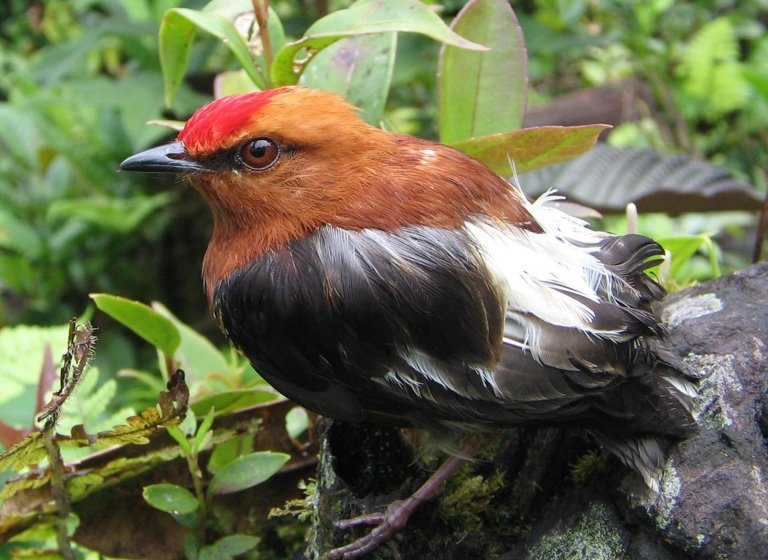- A new study identifies 67 communities with high potential for developing birdwatching ecotourism in Colombia.
- The country is home to more than 1,900 bird species, including 443 rare birds ‘highly valued by bird watchers.’
- The authors present ecotourism as an alternative to mining and logging as rural communities look for ways to develop economically after a decades-long conflict.
Colombia is home to more bird species than any other country on Earth. It’s also well-known for a long-simmering conflict that has only recently begun to cool. Now, a pair of scientists based in Switzerland has mapped out the possibilities for birdwatching ecotourism to bolster economic development and safeguard forests as the country emerges from decades of strife.
In Colombia, “The bird diversity is seemingly endless and birds come in waves of gaudy colors,” said R. Scott Winton, an ecologist at the Swiss Federal Institute Zurich, in an email to Mongabay. “Each new site visited brings a new set of species.”

A recent peace agreement between the government and the Revolutionary Armed Forces of Colombia in 2016 means that many spots in the country, once off-limits due to the presence of armed groups, are now open to visitors. In a study published today in the journal Tropical Conservation Science, Winton and fellow ecologist Natalia Ocampo-Peñuela identified the locations where rare birds — the ones that birders often seek out — hang out in Colombia using known ranges and a citizen science database called eBird. They then looked for overlap with communities that are trying to develop after the conflict.
Their analysis revealed 67 spots where birdwatching could be successful.

“The fact that many places had remained inaccessible for 50 years means that discovery still awaits,” said Ocampo-Peñuela, also of the Swiss Federal Institute Zurich. “With peace, birders will flock to Colombia.”
In large part, so many bird species — 1,942 to be exact, including 74 found nowhere else on Earth — reside in Colombia because of the country’s unique and striking geography.
“Colombia has a privileged location,” she said. Unlike any other Andean country, the mountain range splits into three separate spines through the country, known as “cordilleras,” creating unique habitats that stretch from high plateaus, or “paramos,” down to rivers in the valleys below.
“Each slope of each cordillera has unique birds, as well as its valleys and paramos,” she said.
That translates into “a ridiculous number of ecosystems for birds to fill,” Winton added.

Many of those ecosystems are still intact largely because of the conflict that Colombia has endured for so long.
“Conflict in Colombia has resulted in the conservation of large tracts of pristine forests because these were protected by the armed groups as the hiding place for them and their illegal crops,” Ocampo-Peñuela said.
Until now, fighting between government and FARC forces has kept loggers, ranchers and miners interests at bay. But now that these areas are once again accessible by outsiders, many conservationists are concerned about what will happen next.
“In such an important transition for Colombia, we fear that extractive industries, and the hope to make quick cash, will lead to the destruction of many important habitats,” Ocampo-Peñuela said.
She and Winton contend that the development of ecotourism, centered on birdwatching, will help to ensure the preservation of these habitats since the birds won’t stick around if they’re destroyed. What’s more, they say that ecotourism would be beneficial to local communities. The National Audubon Society says that 150,000 birdwatchers from the United States alone could visit Colombia in the next 10 years, which could create 7,500 jobs and $47 million in income.
“[Extractive] industries do create rural jobs, but often in an ephemeral boom-bust manner,” Winton said. “Plus, in their wake, they leave a degraded landscape less able to deliver other public goods, such as clean water.”

By contrast, locals can expect higher-paying jobs to meet the needs of typically well-off birdwatchers, and income from this type of employment is more likely to stay in the community than be siphoned off by large corporations.
“So even if birdwatching tourism generates a much smaller gross compared to extraction, a much higher percentage will be delivered to rural communities in most need of economic stimulus,” Winton said.
That’s a powerful incentive to protect the environment, he added.
“Once people realize people will pay a lot of money to see their birds, suddenly the forest has a lot more value in an intact state and the calculation of whether or not to clear it for a cattle pasture changes.”

CITATION
Ocampo-Peñuela, N., & Winton, R. S. (2017). Economic and Conservation Potential of Bird-Watching Tourism in Postconflict Colombia. Tropical Conservation Science, 10, 1940082917733862. https://doi.org/10.1177/1940082917733862
Banner image of birdwatchers by R. Scott Winton.
FEEDBACK: Use this form to send a message to the author of this post. If you want to post a public comment, you can do that at the bottom of the page.
Follow John Cannon on Twitter: @johnccannon
